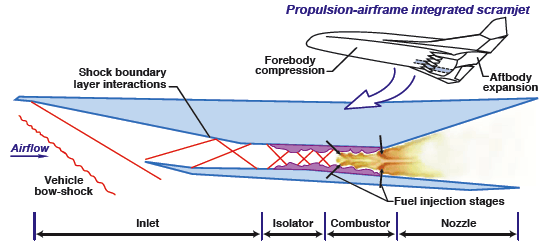|
Scramjet Propulsion |
What is it?

Image Source:
http://www.nasa.gov/centers/langley/news/factsheets/X43A_2006_5.html
A scramjet is a supersonic combustion ramjet. Ramjets utilize the forward velocity of the aircraft as the mechanism for compressing the oxygen used in
its combustion process. This contrasts the process utilized in normal turbofan jet engines in which a portion of engine itself (fan blades) is used to
compress the airflow. Thrust is generated by the combustion of fuel injected into this compressed air stream. This fuel-air mixture is then ignited and
expelled out of the rear nozzle of the engine generating thrust for the aircraft. Airflow through traditional ramjets is subsonic, however vehicles
propelled by ramjets typically operate at speeds ranging from Mach 3 to Mach 6. This means that the air entering the ramjet must be slowed my some
means. Scramjets (supersonic combustion ramjets) differ from ramjets in the sense that the entering airstream remains at supersonic velocities during
the entirety of its time the engine. The maximum speed at which scramjets are able to effectively operate is envisioned to be in the range of Mach 15 at a
minimum. Tests of scramjet combustion on the ground support theoretical potential, however no flight tests have achieved this velocity. The current
speed record achieved during flight tests remains Mach 9.6, which was reached during a flight by NASA's X-43A experimental aircraft.
Background Image
By: Lynn Chambers
Retrieved From: http://science-edu.larc.nasa.gov/SCOOL/cirrus.html

Image Source:
http://www.nasa.gov/centers/langley/news/factsheets/X43A_2006_5.html
A scramjet is a supersonic combustion ramjet. Ramjets utilize the forward velocity of the aircraft as the mechanism for compressing the oxygen used in
its combustion process. This contrasts the process utilized in normal turbofan jet engines in which a portion of engine itself (fan blades) is used to
compress the airflow. Thrust is generated by the combustion of fuel injected into this compressed air stream. This fuel-air mixture is then ignited and
expelled out of the rear nozzle of the engine generating thrust for the aircraft. Airflow through traditional ramjets is subsonic, however vehicles
propelled by ramjets typically operate at speeds ranging from Mach 3 to Mach 6. This means that the air entering the ramjet must be slowed my some
means. Scramjets (supersonic combustion ramjets) differ from ramjets in the sense that the entering airstream remains at supersonic velocities during
the entirety of its time the engine. The maximum speed at which scramjets are able to effectively operate is envisioned to be in the range of Mach 15 at a
minimum. Tests of scramjet combustion on the ground support theoretical potential, however no flight tests have achieved this velocity. The current
speed record achieved during flight tests remains Mach 9.6, which was reached during a flight by NASA's X-43A experimental aircraft.
| Introduction |
Overview |
Thrust |
Drag
& Other Factors |
Bibliography |
Retrieved From: http://science-edu.larc.nasa.gov/SCOOL/cirrus.html